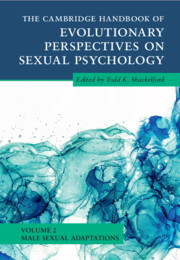Book contents
- The Cambridge Handbook of Evolutionary Perspectives on Sexual Psychology
- The Cambridge Handbook of Evolutionary Perspectives on Sexual Psychology
- Copyright page
- Contents
- Contributors
- Preface
- Part I Precopulatory Adaptations
- Part II Copulatory Adaptations
- 8 Sexual Fantasy
- 9 Ejaculation Latency
- 10 Copulatory Thrusting in Males
- 11 Men’s Provisioning of Oral Sex
- 12 Inducing Female Orgasm
- 13 Copulatory Urgency
- Part III Postcopulatory Adaptations
- Index
- References
10 - Copulatory Thrusting in Males
from Part II - Copulatory Adaptations
Published online by Cambridge University Press: 30 June 2022
- The Cambridge Handbook of Evolutionary Perspectives on Sexual Psychology
- The Cambridge Handbook of Evolutionary Perspectives on Sexual Psychology
- Copyright page
- Contents
- Contributors
- Preface
- Part I Precopulatory Adaptations
- Part II Copulatory Adaptations
- 8 Sexual Fantasy
- 9 Ejaculation Latency
- 10 Copulatory Thrusting in Males
- 11 Men’s Provisioning of Oral Sex
- 12 Inducing Female Orgasm
- 13 Copulatory Urgency
- Part III Postcopulatory Adaptations
- Index
- References
Summary
In sexually reproducing species, male and female gametes fuse to generate offspring. Behavioral patterns have evolved that bring male and female gametes into physical contact. These behaviors range from stereotyped coordinated reciprocal movements displayed by females and males in animals with external fertilization (most fishes and amphibia), to a wide variety of behaviors in animals with internal fertilization. We present an overview of some of the few species for which behavioral data are available. Copulatory behavior in mammals comprises the execution of mounting of the male onto the female’s rump, intravaginal penile insertion, and ejaculation. These events occur either sequentially within a single behavioral pattern or as a series of discrete mounts with or without intromission and ending with ejaculation. In many mammals, male pelvic thrusting at mounting (preinsertive thrusting) is necessary for stimulating the female to assume lordosis and for achieving penile insertion and ejaculation. Wide differences exist across species, however, in the number, sequence, and characteristics of mounting and intromission preceding ejaculation, and in the persistence of thrusting during penile insertion. Thus, intravaginal pelvic thrusting is one of the criteria proposed for classification of male copulatory patterns. In some species, accelerometric and polygraphic techniques have been used to generate detailed descriptions of the dynamic characteristics of motor patterns displayed during thrusting, including vigor, frequency, and rhythmicity. This methodology has allowed us to identify the occurrence of intravaginal thrusting during the ejaculatory behavioral pattern in the rat. We identified two types of ejaculatory responses, with differences in the dynamic organization of the pelvic thrusting train and in the duration of the intravaginal thrusting period preceding ejaculation. This technique also allowed us to identify a period of fast intravaginal thrusting associated with ejaculation in the guinea pig, golden hamster, and mouse. A summary of the neurophysiology and endocrinology of thrusting is provided for those species for which sufficient data are available. Finally, the possible adaptive significance of preinsertive and postinsertive thrusting is discussed.
Keywords
- Type
- Chapter
- Information
- Publisher: Cambridge University PressPrint publication year: 2022

